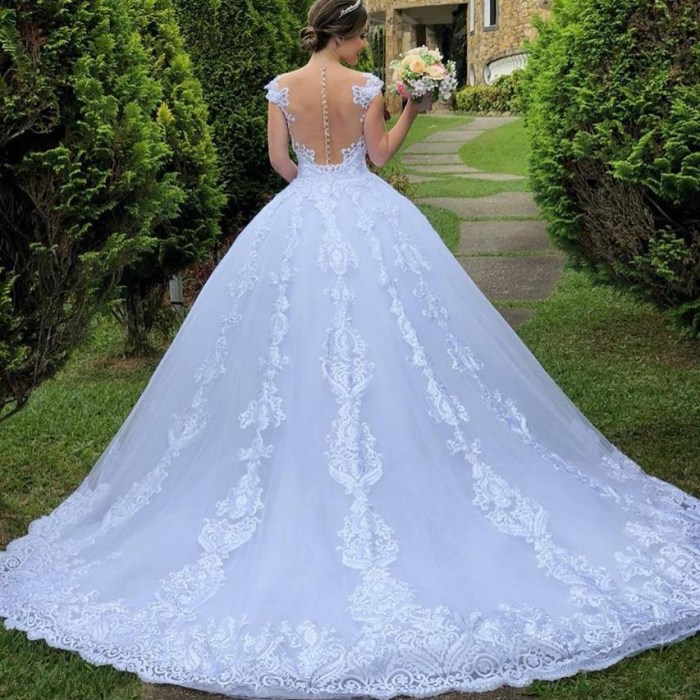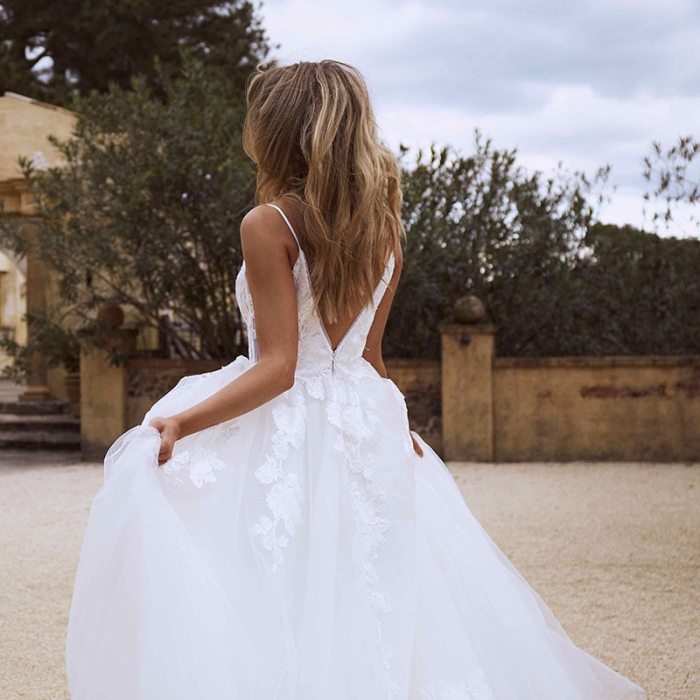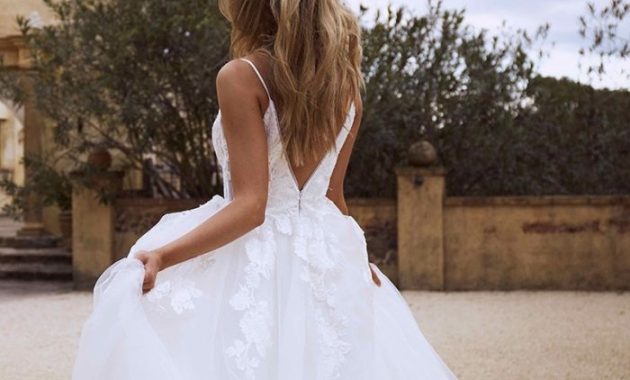A Timeless Elegance: Exploring the World of White Vintage Wedding Dresses

Source: aliyuncs.com
The allure of a white vintage wedding dress transcends fleeting fashion trends. It whispers stories of bygone eras, embodying romance, sophistication, and a touch of timeless charm. This exploration delves into the rich history, design elements, sourcing, preservation, and modern interpretations of these captivating gowns, offering a comprehensive guide for brides seeking a uniquely elegant and historically significant wedding attire.
Historical Context of White Wedding Dresses, White vintage wedding dress
The tradition of wearing white for weddings is surprisingly recent. Before the mid-19th century, wedding attire varied greatly depending on social class and regional customs. Queen Victoria’s choice of a white satin gown for her 1840 marriage to Prince Albert popularized white as the preferred color for bridal wear, establishing a trend that continues to this day. This shift solidified white as a symbol of purity, innocence, and affluence, shaping the evolution of bridal fashion for generations to come.
Silhouettes and styles evolved significantly throughout the 20th century. The 1920s saw the rise of the flapper-inspired dresses with dropped waists and loose, flowing fabrics. The 1950s brought the iconic full-skirted gowns, often featuring cinched waists and elaborate embellishments. The 1970s embraced bohemian styles with flowing fabrics, long sleeves, and a more relaxed, less structured silhouette.
Fabric and embellishment choices also reflected the aesthetic of each era. Early vintage dresses often utilized heavier fabrics like satin and silk, while later decades incorporated lighter materials like lace, tulle, and chiffon. Embellishments ranged from delicate lace and beading to more elaborate embroidery and even sequins, reflecting the changing tastes and technological advancements in textile production.
| Decade | Silhouette | Common Fabrics | Notable Details |
|---|---|---|---|
| 1920s | Dropped waist, A-line, loose-fitting | Silk, chiffon, beaded lace | Long or short hemlines, fringe, beading |
| 1930s | Bias-cut, flowing, figure-hugging | Silk crepe, satin, charmeuse | Long sleeves, cowl necklines, subtle embellishments |
| 1940s | Shouldered, nipped waist, full skirt | Silk, satin, lace | Puff sleeves, cinched waists, floral motifs |
| 1950s | Full skirt, cinched waist, fitted bodice | Lace, tulle, satin | Long sleeves, sweetheart necklines, petticoats |
| 1960s | A-line, sheath, empire waist | Lace, chiffon, silk | Simple lines, modest necklines, minimal embellishments |
| 1970s | Bohemian, flowing, empire waist | Lace, chiffon, cotton | Long sleeves, bell sleeves, floral patterns |
Design Elements of White Vintage Wedding Dresses
Several key characteristics distinguish a vintage wedding dress from modern designs. These include the use of period-specific silhouettes, fabrics, and embellishments. Understanding these elements is crucial in identifying and appreciating the unique features of each era.
Necklines, sleeves, and hemlines varied significantly across decades. High necklines and long sleeves were common in earlier eras, while lower necklines and shorter sleeves became more prevalent in later decades. Hemlines fluctuated, ranging from floor-length to ankle-length, reflecting the fashion trends of each period.
Lace, beading, and other embellishments played a significant role in adding detail and elegance to vintage gowns. Delicate lacework, intricate beading, and subtle embroidery were often used to enhance the overall design, creating a sense of refined craftsmanship.
Below are three distinct vintage-inspired wedding dress designs:
- 1920s Flapper-Inspired Gown:
- Fabric: Lightweight silk chiffon
- Embellishments: Delicate beading along the neckline and hemline
- Silhouette: Dropped waist, A-line, knee-length
- 1950s Classic Full-Skirted Dress:
- Fabric: Tulle and Alençon lace
- Embellishments: Intricate lace appliqués on the bodice and skirt
- Silhouette: Fitted bodice, full circle skirt
- 1970s Bohemian Gown:
- Fabric: Lightweight cotton eyelet lace
- Embellishments: Simple embroidery details on the bodice
- Silhouette: Flowing A-line, empire waist
Finding and Preserving White Vintage Wedding Dresses
Sourcing authentic vintage wedding dresses requires careful research and attention to detail. Antique shops, online marketplaces like Etsy, and consignment stores specializing in vintage clothing are excellent starting points. Reputable online auction sites can also yield unique finds.
Assessing the condition and authenticity of a vintage dress requires expertise. Look for signs of wear and tear, such as loose seams, stains, or damaged fabric. Research the maker’s marks and construction techniques to verify authenticity. Consulting a professional vintage clothing expert is recommended.
Cleaning and preserving a vintage wedding dress requires a delicate approach. Professional cleaning by a specialist experienced in handling delicate fabrics is highly recommended. Avoid harsh chemicals or aggressive cleaning methods that could damage the dress.
Careful storage is crucial to prevent damage. Store the dress in an acid-free archival box or garment bag in a cool, dry, and dark place. Avoid exposure to direct sunlight or humidity.
Modern Interpretations of White Vintage Wedding Dresses

Source: evelynbelluci.com
Modern designers frequently draw inspiration from vintage styles, creating contemporary gowns that incorporate classic elements with modern twists. This blend of old and new results in unique and elegant designs that appeal to modern brides.
Many contemporary designers incorporate vintage elements like lace, beading, and specific silhouettes into their collections. They often reinterpret classic designs, adapting them to suit modern aesthetics and body shapes. The appeal of vintage-inspired dresses lies in their timeless elegance and unique character.
Incorporating vintage-inspired details into a modern wedding look is easily achievable. Here are a few examples:
- Lace detailing on a modern sheath dress
- A vintage-inspired headpiece or veil
- Pearl or crystal jewelry reminiscent of past eras
- Gloves or a bolero jacket to add a touch of vintage flair
Illustrative Examples of White Vintage Wedding Dresses
Visualizing the beauty and unique characteristics of vintage wedding dresses through detailed descriptions can help brides appreciate their diverse styles and elegance.
A 1930s bias-cut gown drapes elegantly over the body, showcasing the fluidity of the fabric. The silk crepe or satin clings to the figure, highlighting the curves while creating a sense of effortless sophistication. The long sleeves and cowl neckline add a touch of glamour.
A 1950s full-skirted wedding dress exudes a classic Hollywood charm. Layers of tulle create a voluminous skirt, often complemented by intricate lace appliqués on the fitted bodice. The sweetheart neckline and long sleeves complete the romantic look. The fabric’s texture – whether delicate lace, crisp tulle, or luxurious satin – contributes significantly to the overall effect.
A 1970s bohemian-style wedding dress embodies free-spirited elegance. Flowing fabrics like cotton or chiffon create a relaxed silhouette, often featuring long sleeves or bell sleeves. The empire waist emphasizes a natural, comfortable fit. Delicate embroidery or lace details might adorn the bodice, adding a touch of romanticism to the overall design.
Question Bank: White Vintage Wedding Dress
How much should I expect to pay for a vintage wedding dress?
The price varies greatly depending on the dress’s age, condition, designer (if known), and fabric. Expect to pay anywhere from a few hundred to several thousand dollars.
Where can I find a seamstress experienced with vintage wedding dresses?
Check online directories, ask for recommendations from antique shops specializing in clothing, or contact local bridal boutiques. Many experienced seamstresses are adept at working with delicate vintage fabrics.
Can I alter a vintage wedding dress significantly?
Significant alterations are possible, but it’s crucial to work with an experienced seamstress who understands vintage construction techniques to avoid damaging the dress. Discuss alterations carefully and get a clear understanding of what’s feasible.
How do I know if a vintage wedding dress is authentic?
The allure of a white vintage wedding dress is undeniable; its timeless elegance speaks volumes. However, if you’re a guest considering a white dress, remember to tread carefully. For inspiration on appropriate white attire, check out this helpful guide on white dresses to wear to a wedding , which offers alternatives to the bridal look. Ultimately, the key is to ensure your outfit complements the occasion without overshadowing the bride’s special white vintage wedding dress.
Examine the construction, fabric, and details carefully. Look for hallmarks of the era, such as specific stitching techniques or types of embellishments. A reputable seller should be able to provide information about the dress’s history and provenance.

